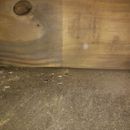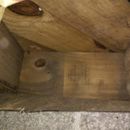Rim joist seal in house without sill plate
Hey all, I just bought a 1943 1500 sqft house in East TN, climate zone 4a. The house has a crawl space, and the first thing I plan to do down there is sealing the rim joists since it seems like a pretty straightforward job.
However, my house is kind of weird in that it doesn’t have sill plates. Instead, the joists sit on top of what appears to be thick tar paper which I can only assume is a capillary break to prevent water from migrating up the CMU block foundation into the wood of the joists. I’ve attached a few photos of the rim joist area, one “straight on” so you can see the CMU and one from the top so you can see the tar paper extends all the way to the rim joist.
Not all areas on top of the foundation have the tar paper, but it seems like it’s in place for most if not all of the joists to sit on.
I believe all the joist/foundation transitions are above grade, since I can see at least 1′ of block all around the house. Also, I’m at the highest elevation in my city, so water is generally not a huge deal. I think I have some mold in there but no rot or standing water, etc. Dehumidifier in operation 24/7.
So I did some strategic Googling and I read the following first, although this guys’ issues are a lot more complicated than mine: thread:https://www.greenbuildingadvisor.com/question/rim-joist-insulation-no-wood-sill-plate-influence-on-rigid-foam
Just wanted to ask the following:
1. Is there anything peculiar to my situation that would change how I should do a “rim joist rigid foam with great stuff spray foam at the perimeter” type job? Thoughts would be the adequacy of the tarpaper as a capillary seal such that the rigid/spray foam would be okay contacting the tarpaper at the bottom of the rim joist, etc., and not move water to the rim joist/joists.
2. Expansion of #1: for termite inspection, I often hear to leave the sill plate visible. Since I don’t have a sill plate, I’m not really sure if I have any analogous “inspection spot” – maybe just making sure the tar paper is visible? Any insight here?
Thank you very much,
Eric
GBA Detail Library
A collection of one thousand construction details organized by climate and house part











Replies
Hi Eric -
Tar paper does not constitute a capillary break. But this does not look like tar paper, frankly. It appears to be much thicker, almost like an asphalt rolled roofing product? If so, that IS a capillary break (non porous, not supporting wicking of liquid water).
It is possible that if that material between the floor framing and the top of the CMU is asphalt roofing, and you can keep its terminating edge visible, IT acts as your termite shield.
Peter
Yes, there is visible asphalt or tar in different areas that looks like it dripped off during construction. Also, the product is about the thickness of a roofing shingle. Good call!
That is asphaltic fiberboard. My house is the same way. I wasn’t sure what it was myself until I posted a question on here and Dana recognized what it was, so I’m passing his answer along to you.
It’s not a capillary break. What I’ve been doing is to lift sections of the house up a little with jacks and then slide in a piece of 1/32” HDPE sheet. It sounds like a huge project but it’s really not, aside from having both basement and crawlspace areas to deal with.
If you’re in a termite prone area, the inspection strip is a requirement. If you're not in such an area, then you don’t need to leave that gap.
The biggest issue with no capillary break is the increased potential for the rimjoist to get wet and not dry once you seal it with insulation. There are two ways to deal with this: I think the best way is to install a capillary break, then you can insulate the rimjoist however you want (I used a two part spray foam kit). The other option is to use EPS as your insulation, sealed in with great stuff, since EPS will allow for some drying in reasonable thicknesses.
Bill
Hey Bill, I really appreciate the reply, this is a very important consideration. I would just accept higher energy costs if I knew I was putting myself at serious risk of rot!
The good news is that I don't think my "asphalt stuff" (between the rim joists/joists and foundation wall) is asphaltic fiberboard, so it's probably a legit vapor barrier. The reason is that compared to your picture (I searched and found your older post, attached your pic for other's reference) my product is really, really thin, like easily less than 1/8". In addition, the part that overhangs the CMU blocks on the interior side "droops down" towards the crawlspace floor a bit (it's somewhat flexible like a roof shingle). You can kind of see this in my second photo. I would not be surprised if they were shingles, this house was built during WWII.
So I guess my largest concern is still whether the "shingles" are an adequate capillary break, but Peter's response is reassuring that if they would be. This thread goes into capillary breaks a bit, and Martin thinks that even without any capillary break, it's still typically worth doing the insulation job. https://www.greenbuildingadvisor.com/question/will-spray-foam-at-a-rim-joist-affect-the-wood
One thing I noticed is there are a few sections missing the "shingles." If I move forward with the insulating, I'll probably keep the insulation off these areas out of an abundance of caution.
I wish I could claim to be comfortable with jacking the house up, but offhand I find this fairly terifying. I'll watch some Youtube videos but... yeah, not sure about that option.
I priced out some GPS (EPS with graphite today) and that would probably be my choice based on the vapor permiability considerations you mentioned, Bill.
Thank you again,
Eric
Oh yeah, I guess I have a few other datapoints in the "against insulating" corner:
1. The above-grade portion of the CMU foundation wall is painted (less drying outward of water wicked from the ground)
2. I plan on sealing the interior foundation wall with a vapor barrier (continuing the barrier from the floor up the CMU), leaving a few inches up top still exposed. This is even less drying potential, fortunately for the rest of the house but unfortunately for the rim joist.
Eric
Break off a piece of what you have to see what’s inside. If it’s an asphalt shingle, it will be saturated and solidly full of the black asphalt compound. If it’s asphaltic fiberboard like I have, it will be a dry fibery material inside a little bit like heavy cardboard.
All you need is a capillary break. Concrete walls don’t need any drying I either direction, concrete can remain wet forever and not care. We build dams in rivers out of concrete after all :) you just have to make sure the water doesn’t wick upto the sill plate and wet that wood. That’s what the capillary break is for — it stops the migration of water from the concrete (where moisture doesn’t matter), to the wood (where moisture matters).
Bill
Will do, thanks Bill!
Hi SC -
your exterior paint on concrete: if it is a latex paint it may be protecting your concrete from liquid water (splashback) but has decent vapor permeability.
Peter
Peter, that's great info. One of the previous owners did the painting but they left me a treasure trove of paint so I'll see if I can identify the type of paint used...
Thank you again,
Eric